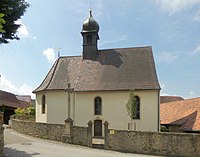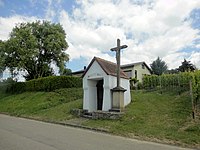Pfaffenweiler
| coat of arms | Germany map | |
|---|---|---|

|
Coordinates: 47 ° 56 ' N , 7 ° 45' E |
|
| Basic data | ||
| State : | Baden-Württemberg | |
| Administrative region : | Freiburg | |
| County : | Breisgau-Upper Black Forest | |
| Height : | 252 m above sea level NHN | |
| Area : | 3.61 km 2 | |
| Residents: | 2613 (Dec. 31, 2018) | |
| Population density : | 724 inhabitants per km 2 | |
| Postal code : | 79292 | |
| Area code : | 07664 | |
| License plate : | FR | |
| Community key : | 08 3 15 089 | |
| LOCODE : | DE VAT | |
| Community structure: | 2 districts | |
| Address of the municipal administration: |
Rathausgasse 4 79292 Pfaffenweiler |
|
| Website : | ||
| Mayor : | Dieter Hahn | |
| Location of the community of Pfaffenweiler in the Breisgau-Hochschwarzwald district | ||
Pfaffenweiler (Alemannisch Pfaffewiler ) is a municipality about ten kilometers south of Freiburg im Breisgau on the northern edge of the Markgräflerland .
The place is known, among other things, for the snail festival that takes place every year on the first weekend in September.
geography
Geographical location
Pfaffenweiler is located in the so-called Schneckental in the northern Markgräflerland between the Batzenberg in the west and the Hohfirst as part of the Schönberg massif in the east. The Duffernbach flows through the valley.
geology
The Schönberg massif consists of rock layers from red sandstone to tertiary . The stone was mined in several quarries by local stonemasons until the beginning of the 20th century. You can still visit the historic quarries today.
Neighboring communities
Pfaffenweiler is bordered by Schallstadt and Ehaben in the north, Bollschweil in the east, Kirchhofen (OT von Ehrenkirchen ) in the south and Norsingen and Scherzingen (both belonging to Ehrenkirchen ) in the west.
Community structure
The community consists of the villages Öhlinsweiler (alem. Ehlischwiler ), the upper village, and Pfaffenweiler, the lower village.
history
The place was possibly first mentioned as Openwilare in a deed of donation from Rebland to the St. Gallen monastery: Propterea vernacula terra juris mei in loco, qui dicitur Openwilare, tradimus sancto Galloni viginti juchos, et in Eberingen unum juchum de vinea. The document is dated 16 January during the reign of the Frankish King Chilperich II , who ruled from June 715 to March 721, without a year, only the ruling King Chilperich (without number) is mentioned. The internal conditions of the Franconian Empire make the establishment of the document in 720 most likely, since Chilperich II only ruled the East Franconian Empire, in which Pfaffenweiler and St. Gallen were located, only from the end of 719, before only the Western Empire. It does not seem plausible that a dating to a West Franconian ruler would have been made in the Eastern Empire. The reign of Chilperich I (561-584) is ruled out because the St. Gallen monastery did not yet exist at that time. There were no other Chilperichs.
The research assumes, however, that Openwilare was probably not Pfaffenweiler or Öhlinsweiler, but a later abandoned hamlet in the northern Schneckental between Pfaffenweiler and Wolfenweiler, in the area of today's municipal boundaries of both localities. Several such hamlets are occupied for the time in the Schneckental.
From the end of the Middle Ages on, Pfaffenweiler belonged to the Staufen rulership as a manor and came under Austrian sovereignty in the second half of the 14th century .
For centuries, stone carving was an important line of business alongside agriculture and viticulture. In 1561, the sculptor Jörg Kempf created the pulpit of the Freiburg Minster from Pfaffenweiler limestone. Probably the oldest inn is the "Stube" in the district of Öhlinsweiler, which was built in 1574/75. As a "parlor" it also served as an official building.
During the Thirty Years War , Freiburg, Austria, was occupied in 1632 by a Protestant alliance of Baden-Durlach, Saxe-Weimar and Sweden. Austria was initially able to hold Breisach. At the beginning of June 1633, troops from the Imperial Austrian garrison there - and in their wake also the inhabitants of the Austrian villages of the Staufen rule - plundered the villages of the Protestant Markgräflerland south of Pfaffenweiler. These belonged to the margraviate of Baden-Durlach. In response, Swedish-Baden troops occupied the area a few days later and took up quarters in Kirchhofener Castle. On June 19, 1633, they rounded up a few hundred residents of the surrounding villages, including over 80 residents from Pfaffenweiler and Öhlinsweiler, who at that time numbered around 400 to 500 residents. The men were killed while running the gauntlet. The women and children suffocated and burned to death in the tower of the Kirchhofen Castle. In total, over 300 people were massacred. The remains of the dead were buried in an ossuary near the Kirchhofen church.
In the following years the area was also fought over between imperial and Protestant, and from 1638 onwards French troops. In the Peace of Westphalia , the affiliation of the Breisgau to Austria was then confirmed.
In 1803, the Breisgau and with it Pfaffenweiler was spun off from the Austrian state and transferred to the Duke of Modena as compensation for his lost possessions in Italy. After the Duke's death, his daughter, who was married into the House of Habsburg, inherited the Breisgau, so that Habsburg rule continued. After the Peace of Pressburg in 1805, however, the Habsburg rule in Breisgau finally ended and on April 15, 1806 Pfaffenweiler was also handed over to Baden-Durlach, which had become the Grand Duchy of Baden . In the same year the Kirchhofener ossuary was demolished and the Staufen manor was abolished.
From 1492 to 1811 the village of Scherzingen on the other side of the Batzenberg belonged to Pfaffenweiler. Scherzingen then became independent and has belonged to Ehrenkirchen since the local government reform in 1974 .
politics
Municipal council
The local election on May 26, 2019 resulted in the following distribution of seats:
| CDU | 46.3% | 5 seats |
| Free list of citizens | 53.7% | 7 seats |
mayor
Mayor is Dieter Hahn. He was confirmed for a second term in October 2014. He is also a member of the municipal council as its chairman.
coat of arms
Blasonierung : "In three golden red, with just such patens covered goblets (1: 2)."
Community partnerships
- Jasper (Indiana) , USA: Around 1850 numerous Pfaffenweiler emigrated to North America and settled in the Jasper settlement. Pfaffenweiler family names such as Eckerle, Eckert, Gutgsell, Kiefer, Scherle and Elmlinger can still be found there today.
Culture and sights
Buildings
- Catholic Parish Church of St. Columba
- Gasthaus Stube
- Historic vineyards
- Historic quarries
- Chapels in Pfaffenweiler
Monuments and landmarks
- Hohebannstein (district stone in the Hohfirstwald, bordered by the five municipalities of Bollschweil , Eringen , Ehrenkirchen , Pfaffenweiler and Schallstadt . In the meantime, there is only one replica on site, the original stone is in the Pfaffenweiler village museum)
- Africa monument at the edge of the forest on the Dürrenberg
Museums
- Village museum (at the town hall)
- historical quarries (open-air museum)
societies
- VfR Pfaffenweiler (soccer)
- TC Pfaffenweiler (tennis)
- TV Pfaffenweiler (gymnastics)
- Schnecke-Narren Pfaffenweiler eV (local Fasnet customs)
- TTC Pfaffenweiler (table tennis)
- SSV Pfaffenweiler (sport shooting)
- AMC Pfaffenweiler (kart slalom)
Regular events
The well-known national snail festival in Pfaffenweiler has been held annually on the first weekend in September for many years. Along the Kapellenstrasse in Oberdorf (Öhlinsweiler) farms and cellars are used by the local associations to offer local wine and dishes that are partly based on traditional regional cuisine. Feature of the worm festival is the customs show in the annual theme is presented from the craft tradition of the village by the artisans themselves, some with original tools, such Steinhauer / Steinmetz , viticultural approach, etc.
At the Steibick-Fescht , held every year on the last Sunday in June , the members of the Steinhauergruppe show the traditional trade in the open-air museum of historical quarries.
Personalities
- Nikolaus Schuble (1770–1816), organ builder
literature
- Parish Pfaffenweiler (ed.): Pfaffenweiler, a local history by Edmund Weeger. Modo-Verlag, Freiburg 1997, ISBN 3-922675-66-2 .
Individual evidence
- ↑ State Statistical Office Baden-Württemberg - Population by nationality and gender on December 31, 2018 (CSV file) ( help on this ).
- ↑ Information about the snail festival
- ^ The state of Baden-Württemberg. Official description by district and municipality. Volume IV: District Freiburg Kohlhammer, Stuttgart 1978, ISBN 3-17-007174-2 . Pp. 163-164
- ↑ Pfaffenweiler im Schneckental - Snail Festival and Wine in Markgräflerland | Announcement of the results of the municipal council election. Retrieved August 3, 2019 .
- ↑ http://www.badische-zeitung.de/kreis-breisgau-hochschwarzwald/hahn-und-schweizer-bleiben-buergermeister-in-pfaffenweiler-und-bollschweil--92713755.html








